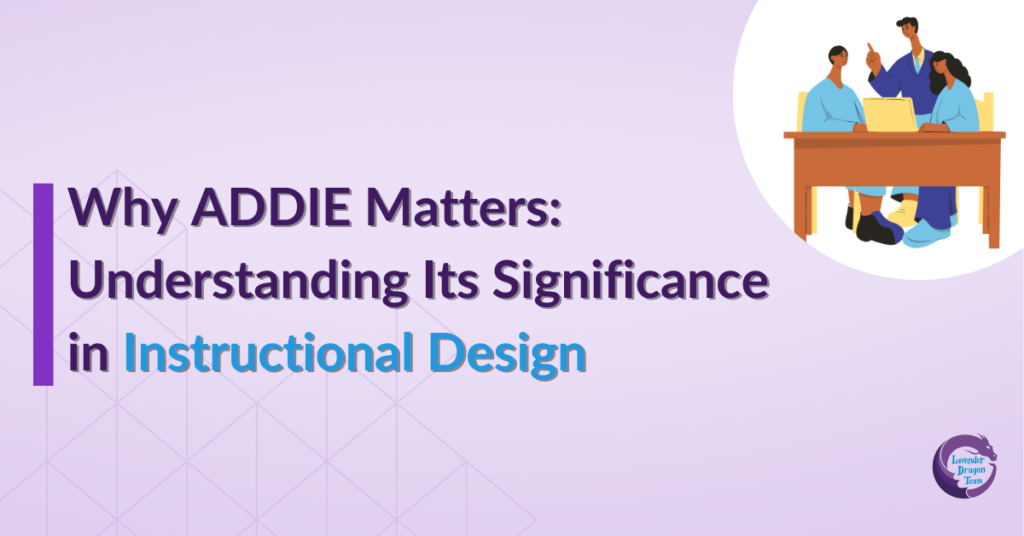In this blog, we’re discussing a topic close to the heart of every instructional designer: the ADDIE model. While new methodologies and tools continue to shape the learning landscape, the enduring relevance of ADDIE in instructional design cannot be overstated. This blog explores why this decades-old framework remains a cornerstone in the field, especially highlighting its adaptability and effectiveness amidst modern learning methodologies.

A Time-Tested Framework
First off, let’s remind ourselves what ADDIE stands for: Analysis, Design, Development, Implementation, and Evaluation. This systematic framework has been guiding instructional designers since the 1970s, and its staying power is a testament to its foundational strength in the design process.
Historical Context and Evolution
Originally developed for the U.S. Military, ADDIE was created to standardize training development. Its clear structure was designed to ensure comprehensive and effective training outcomes. Over the years, as learning needs and technologies have evolved, so has ADDIE. It has been adapted for a wide array of contexts, from corporate training to online learning, proving its flexibility and resilience.
Relevance in Modern Learning Environments
In today’s fast-paced, technology-driven world, one might wonder how a model developed decades ago remains relevant. Here’s why ADDIE still matters:
1. Structured Flexibility
Unlike rigid formulas, ADDIE provides a framework that offers guidance without stifling creativity. This balance is crucial for innovation in learning design. Each phase of ADDIE can incorporate new tools and approaches, from VR and AR to mobile learning and AI-driven analytics.
2. Holistic Approach
From initial analysis to post-implementation evaluation, ADDIE covers every aspect of the instructional design process, ensuring no element is overlooked. Every stage of ADDIE demands alignment with the overarching goals, which is essential for the coherence and integrity of the learning experience.
3. Ensures Quality and Effectiveness
The Evaluation phase feeds insights back into the Analysis phase, allowing for continuous improvements and updates, keeping the material relevant and effective. Numerous case studies and success stories from learning institutions to global corporations highlight the effectiveness of ADDIE-based programs.
ADDIE in the Context of Modern Methodologies
While newer models like SAM (Successive Approximation Model) and Agile design offer alternatives to ADDIE, they don’t necessarily replace it. Instead, they complement it by addressing specific needs that require more rapid iterations or greater flexibility. Here’s how ADDIE integrates with and supports these modern approaches:
- ADDIE’s phases can serve as a blueprint for Agile sprints or SAM iterations, providing a structured approach that these more fluid models can build upon.
- Many designers use a hybrid approach, employing ADDIE’s thoroughness in planning and evaluation with the iterative, responsive nature of Agile or SAM during development.
Application of ADDIE Examples
To illustrate ADDIE’s adaptability and effectiveness, let’s look at a few brief examples:
Corporate Training
A multinational corporation can use ADDIE to overhaul its leadership training program. By thoroughly analyzing learner needs and business goals (Analysis), designing engaging multimedia content (Design and Development), rolling out training across global offices (Implementation), and using learner feedback and performance metrics for course refinement (Evaluation), the program can improve leadership performance metrics.
Higher Education
A university can redesign its online course offerings using ADDIE. This is to ensure that courses were not only academically rigorous but also engaging and accessible to a diverse learner body. The iterative evaluation process helped the university continuously update its courses based on learner feedback and learning outcomes.
Final Thoughts
The beauty of ADDIE lies in its simplicity and depth. While the world of learning technology advances at a breakneck pace, the fundamental principles encapsulated in ADDIE continue to provide a solid foundation for instructional design. Its adaptability means that as long as there are learners and teachers, ADDIE will remain relevant. It can guide the creation of effective and impactful learning experiences.
So, whether you are a seasoned instructional designer or just starting out, consider how ADDIE might enhance your design processes. Remember, great learning experiences don’t happen by accident—they are designed, and ADDIE is one of the best tools in your design toolbox to ensure success.
Read: The Editing Efficiency Challenge with Vyond Go: Tailor Videos to Perfectly Fit Your Brand

